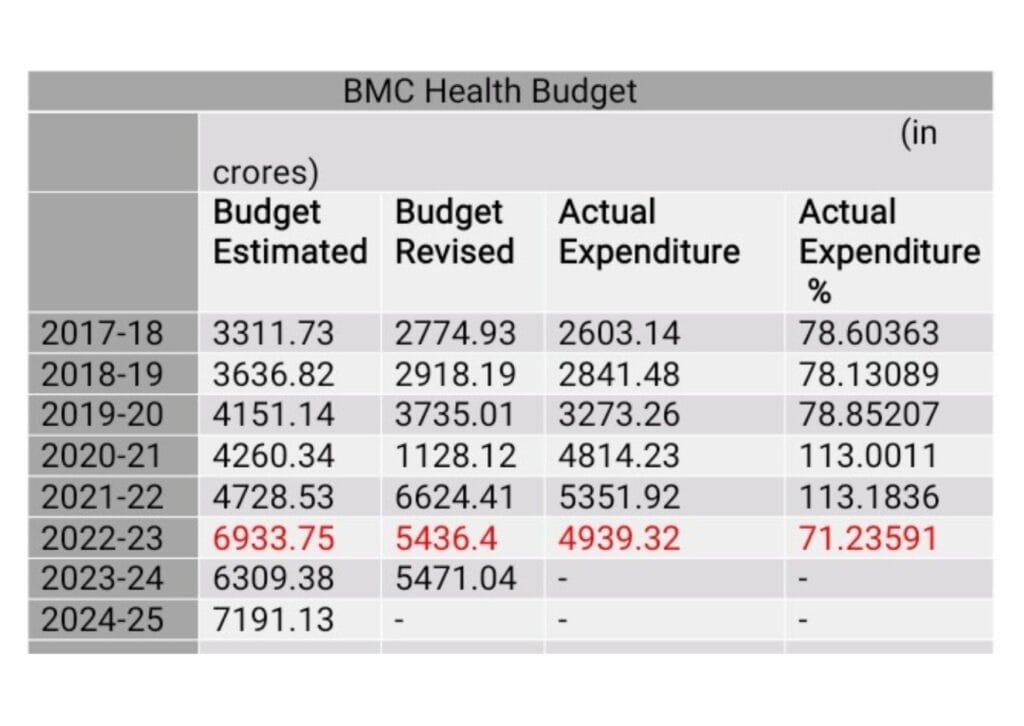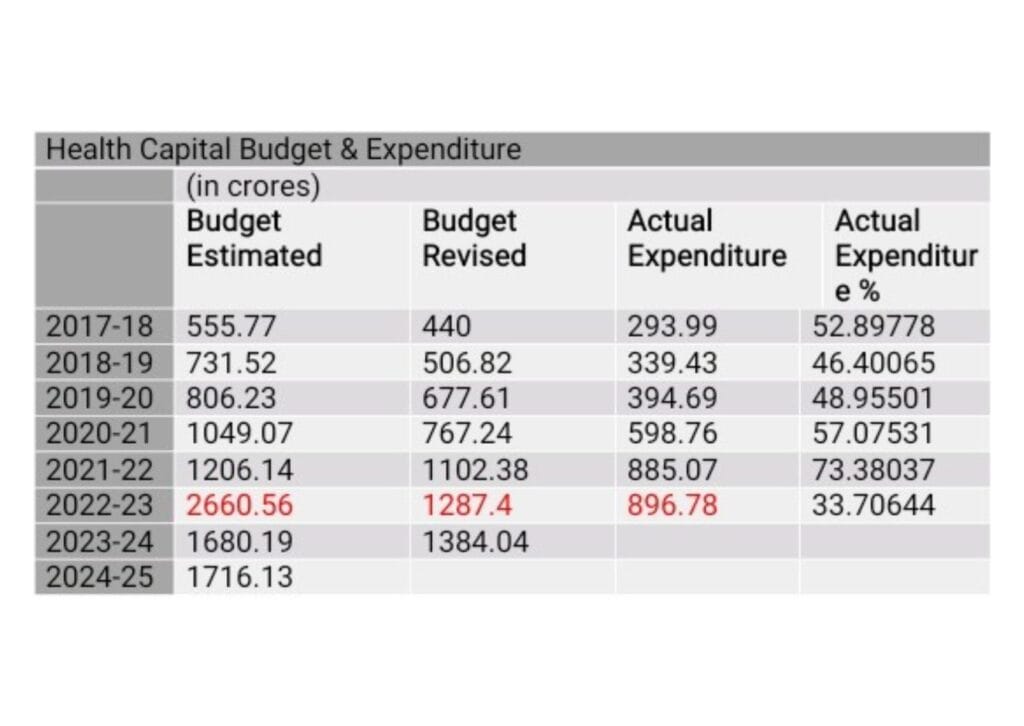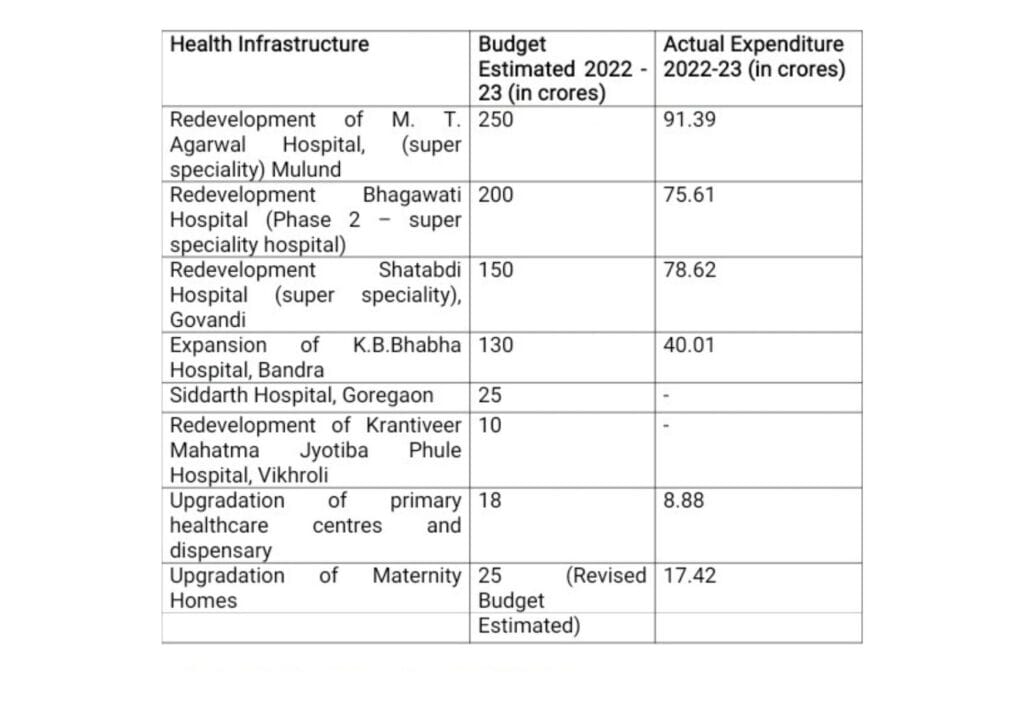After the COVID-19 pandemic, the Brihanmumbai Municipal Corporation (BMC) prioritised healthcare infrastructure in Mumbai. In 2022-23, BMC allocated Rs 6933.75 crore for the health budget, marking a 46% increase from the previous year (2021-22). BMC increased the share of the total budget dedicated to health up to 15%, the highest in the decade. Moreover, BMC invested Rs 2660.65 crore for health capital expenditure, more than doubling the prior year’s allocation.
These funds were primarily focused on completing delayed hospital redevelopment projects, upgrading dispensaries and maternity homes, procuring medical equipment, and expanding health infrastructure across the city.
Health actual budget expenditure has experienced a significant increase of over 70% since 2017-18. As a result, health capital expenditure has consistently surpassed 50% utilisation since 2017. After the promising budget announcement for Mumbai in post pandemic era, there was an expectation of revamping the city’s health infrastructure and making it accessible to all citizens with necessary facilities. However, just a month after the budget presentation, BMC came under administration rule starting on March 8, 2022.


In the first year of administration rule, BMC utilised 71% of the allocated health budget in 2022-23, marking the lowest expenditure in the past five years. Health capital expenditure utilised merely 34%, also the lowest since 2017.
This significantly impacted the development of health infrastructure and several hospital redevelopment projects.
Health capital expenditure has been consistently underutilised for several years, with a notable exception during the COVID-19 pandemic when it surpassed 100%. However, post-pandemic its utilisation has once again decreased. Despite budget allocations, procurement of machines such as MRI and CT scans for municipal hospitals has been delayed for several years.
In 2022-23, BMC allocated a budget of Rs 57 crore for machinery procurement for KEM Hospital, but actually utilised Rs 31 crore. Similarly, for Sion Hospital, BMC allocated Rs 48 crore but utilised Rs 22.13 crore. Nair Hospital utilised only Rs 11.28 crore of the allocated Rs. 49.75 crore.
The underutilisation of health capital expenditure and stalling of major health redevelopment projects has come under criticism, especially since the BMC is under administrator’s rule at present. BMC commissioner Iqbal Singh Chahal did not respond to the queries sent by Citizen Matters.
Read more: KEM hospital gets approval for 24×7 cath lab, what about other hospitals?
Need transparency in utilisation of budget
Economist Ravi Duggal remarked, “The administration rule and delays in municipal elections may be contributing factors to the ineffective utilisation of health capital expenditure. There is a lack of transparency in the BMC’s work processes. These are often influenced by political connections, particularly evident in tendering for hospital redevelopment and procurement of drugs. Perhaps BMC has not utilised the budget, due to surveillance following inquiries into the misuse of funds.”
He further emphasised that the tendering and procurement processes for drugs and machinery must be as transparent like in Tamil Nadu, which enhances the effective use of funds.

A former senior health official attributed the underutilisation of the health budget to the inefficient functioning of the Central Purchase Department. Subsequent inquiries by the Enforcement Directorate have disrupted the operations of the CPD department. Against this backdrop, BMC employees are now reluctant to work in the CPD department.
Samajwadi Party MLA and former corporator Rais Shaikh highlighted that the absence of a monitoring system on administrators is one of the reasons for the underutilisation of the health budget.
He said, “Despite writing letters three times and urging BMC to review ongoing health infrastructure projects and provide financial details, there has been no response. Despite budgetary allocations, BMC has failed to procure even scheduled drugs in hospitals for the past year. Local representatives visit hospitals and report health issues to the BMC administration, expecting prompt action. However, it is not happening now.”
Underutilisation shrinks future health budget
Due to poor utilisation of allocated funds, the BMC administration reduced the health budget by 9% in 2023-24. Consequently, this reduction impacted health capital expenditure, leading to a decrease of 36% compared to the previous year. It decreased the share of the health budget in the total budget to 12% from the previous 15%.
In the revised budget estimates for 2023-24, BMC reduced the health budget from Rs. 6309 crore to 5471 crore. It also decreased health capital expenditure by 18%, which would impact health infrastructure development.
BMC budget for health doubled from Rs 3600 crores to Rs 7000 crores, in 2017 to 2024, due to Covid-19 pandemic. But just allocation did not ensure proportionate upgradation of health care services in Mumbai.
The BMC Audit report for 2021-22 on the health budget noted that an increase in the utilisation of health capital expenditure from 40% to 80% between 2017 and 2021. The report remarked that the actual health capital expenditure and the budget estimate should ideally be the same or relatively equal.
The difference between these two figures indicates unnecessary funds allocated in the budget, which then
Consistent monitoring of budget spending
The official said, “Efficient utilisation of health capital expenditure requires consistent follow-up with the Health Infra Cell (HIC). Hospital redevelopment projects involve time-consuming processes such as drafting maps and issuing tenders. The administration should conduct weekly follow-ups with HIC to expedite these processes, enabling prompt resolution of challenges and obstacle.”
In 2024-25, the BMC has allocated a substantial budget of Rs 7191 crore for health and Rs 1716 crore has been designated for health capital expenditure.
On the backdrop of persistent delays in major health infrastructure projects in recent years, a pertinent question remains: Will this budget allocation suffice to expedite the completion of crucial projects, or will it prove inadequate to meet the urgent demands of our healthcare system?
One can only hope that the BMC effectively utilises this year’s budget to bolster the progress of delayed health infrastructure projects.
(In the next part, we will look at a case of a public hospital, in need of upgradation and the impact it has on patients. )
| Have you faced any problems in accessing facilities at public hospitals? What can be done to improve public health care? Please share your thoughts with us at mumbai@citizenmatters.in. |
Thanks and congrats for a lucid narrative !
1. It is increasingly believed that sub optimal expenditure is attributable to inefficient systems. Macro level observation, however, may need further deep probing to arrive micro level facts.
2. In capital assets, whether the intention of MCGM was to just face lifting and refurbishment of existing physical structures or addition of capacity or new units ?
3. World over experience suggests under utilisation of health facility while refurbishment is ongoing.
4. Optimal utilisation during Covid 19 is understandable as the demand was high.
5. Quality of services is likely to linked largely to recurring budgets (operation maintenance, drugs consumable etc) than just general overhaul of structures. Deep look at it may help to understand the phenomenon better, I think.
6. Staff salary share in expenditure may also need some understanding through analysis. Newspaper gave an understanding that many contractual appointments were given during pandemic which got annulled post waning of pandemic.
7. Break up of budget allocation according to primary health care tier , secondary / tertiary health care may also be useful.
Hope to hear from you